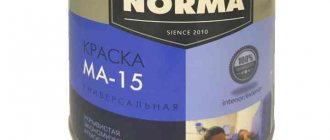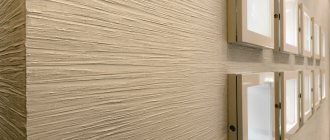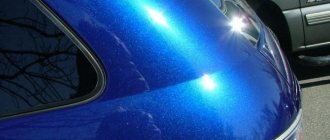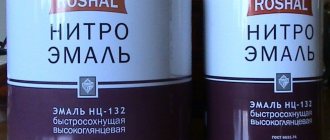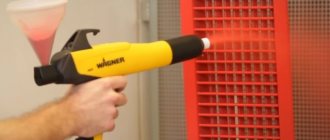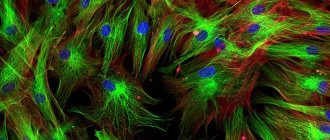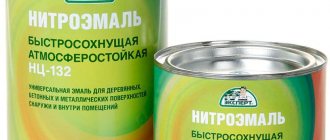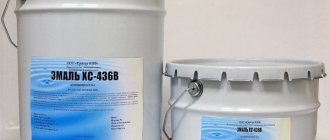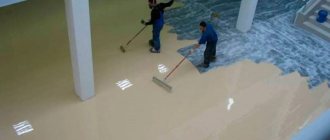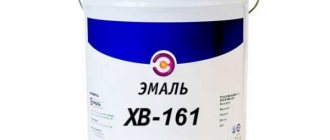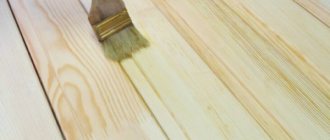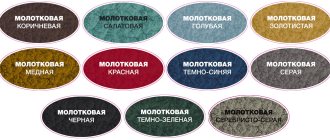Acrylic enamel and acrylic paint have different characteristics, service life when covering surfaces, and operating conditions. Of primary importance is the material that needs to be painted, since the resistance to moisture and breathability of these compositions is different.
Acrylic paint is usually produced white, so tint paint is used to obtain the desired color.
General information
Paintwork materials perform both an aesthetic and protective function. Protect painted surfaces from various negative factors: ultraviolet radiation, high humidity, sudden temperature changes.
Requirements for the use of enamel and paints, regardless of their purpose:
- hiding power - the ability to make the color of the processed material invisible;
- adhesion – adhesion of paintwork materials to the surface;
- environmental friendliness;
- wear resistance – resistance to high humidity and mechanical damage.
Dyes are primarily used to impart a specific color. Enamel is a similar paint and varnish material, but includes the addition of varnish. That is, the difference between enamel and paint lies in the composition. The choice depends on the area of use.
Is it possible to combine acrylic and alkyd materials?
A novice master may wonder: is it possible to use alkyd paints to repaint surfaces on which an acrylic composition has been applied? The same question can be asked in reverse order, but regardless of the coating - be it metal or wood, the answer will be negative. This is due to the fact that applying acrylic enamel over alkyd can lead to the appearance of dark spots or poor adhesion of the composition.
Combination is possible only if the old paint has already served its service life declared by the manufacturer. However, before applying a new type of coating, it is necessary to prime the surface. It is worth considering that the primer must be of the same type as the paint composition being applied.
Alkyd paint characteristics
Solvent-based paints and varnishes contain a volatile organic solvent that evaporates during the drying process. Currently, the only solvent that can be used in all countries of the world without any restrictions is white spirit (purified kerosene).
When working with organosoluble products, certain precautions must be observed. When applying them to large surfaces indoors or in a small confined space, it is necessary to use special personal protective equipment
What is the difference between acrylate paints and acrylic paints?
The binder in acrylic paints consists 100% of the polymer of the same name.
In paints called acrylics, the binders are acrylic and methacrylic. These polymers are derived substances from ethereal elements.
A film-forming substance consisting of 100% acrylic is optimal for facade coatings:
- It makes it possible to create a weather-resistant, elastic, vapor-permeable finish.
- This coating is wear-resistant and durable.
- The polymer film is resistant to ultraviolet radiation and temperature changes.
Acrylate paints contain a copolymer, for example silicone.
But paint on pure acrylic, for all its advantages, has one significant drawback - it is very expensive. Therefore, manufacturers often use binders consisting of a mixture of acrylic and other, cheaper polymers. Such compositions are called acrylate-copolymer or simply acrylate.
Most often, the following are used as an additional binder:
- butadiene;
- styrene;
- vinylpyridine;
- latex;
- polyvinyl chloride;
- polyurethane;
- polyvinyl acetate, etc.
Using these copolymers, it is possible to improve the characteristics of paintwork materials. At the same time, the cost of paint drops by almost 2 times.
Use of material
Water-based acrylate dyes can be applied to almost all types of facades:
- brick;
- concrete;
- wooden;
- metal;
- plastered.
Rules for using the material:
- Facade paints on acrylic are applied to a previously cleaned and primed surface.
- The coating should be applied in 2–3 layers.
- You can work at an air temperature of at least +5 °C and moderate humidity.
- The paint should not come into contact with the user's eyes. Therefore, when finishing the facade you should use personal protective equipment.
Containers with acrylate paint must be stored at a temperature of at least +5 °C. The room should be dry. Buckets should not be exposed to direct sunlight. The guaranteed shelf life of the material is 12 months.
What is the difference between acrylic compositions and what is better to choose enamel or paint
The difference lies in vapor permeability and moisture resistance. As an additional coating, a thin layer of varnish can be applied to the enamel; it does not adhere well to the water-dispersion base and does not affect its durability. Therefore, acrylic paint is better suited for exterior work, and metal fences, doors, and cars can be coated with enamel.
In terms of weather resistance and durability, acrylic materials are clearly superior to alkyd materials, which makes them the best for outdoor use.
An acrylic base is best suited for application to leather, paper, and fabric. This is possible due to the high elasticity and breathability of the composition.
Advantages of using enamel:
- durability of glossy surface;
- brighter and more saturated colors;
- wear resistance;
- creates a protective film;
- When processing metal, it provides additional protection against corrosion.
Acrylic enamel is used not only for work in private construction, but is also used in urban development.
Positive aspects of using acrylic paint:
- allows air to pass through when processing any surfaces;
- resistance to ultraviolet radiation and temperature changes;
- transparency and colorlessness;
- environmental friendliness;
- can be sanded and polished.
The composition of acrylic enamel includes alkyd varnish, coloring pigments, and solvent. Depending on the manufacturer, fire-fighting, antifungal additives, and antiseptics are added to the enamel. After application, drying time can last from several days to several weeks. In addition, the specific smell requires additional ventilation of the room.
Under acrylic paint made from a polymer emulsion, you can use any type of primer or simply paint the base material that has been cleared of dust. The basis of the composition is represented by acrylic resin, dyes, water, which is odorless, as well as chemical impurities. It dries in 2-3 hours, after which it is recommended to immediately apply a second layer for a more uniform coating.
The advantages of acrylic paint lie not only in heat resistance, but also in performance properties. Manufacturers claim that the aesthetic and protective properties of paints are preserved for up to 20 years. High-quality water-dispersed compositions are much more expensive than enamel. Acrylic paint can be diluted with water, taking into account the manufacturer's recommendations specified in the instructions for use.
Comparison of composition and technical characteristics
Acrylic paint contains:
- pigments and fillers needed to determine paint color
- functional additives.
- monomers of acrylic copolymers, this is the base of the paint
- auxiliary monomers that affect the properties of the paint
Functional additives include emulsifiers that affect the surface coating, organic solvents affect the strength of the connection, and stabilizers prevent component particles from settling.
The enamel contains the following components:
- solvents
- pigments for color determination
- additives to determine various functions
- varnish
- fillers
The main differences between the compositions of enamel and acrylic are that the enamels seem to be fused to the surface and delight with their durability, but have a pungent odor. Acrylic, in turn, is characterized by quick drying of the painted area and protects it from damage.
Comparison of consumption per 1 m2
The consumption of enamel or acrylic depends on the surface itself. If the surface is rough, you will have to apply several layers to achieve the desired effect. If the surface to be painted is prepared for paint according to all standards and has a glossy surface, then for acrylic paint 1 - 2 layers and 0.2-0.25 liters per square meter are sufficient. If you cover the surface of the product with it, then when covering in 2 layers you need 100 - 180 grams.
Important! To find out how much acrylic or enamel you need for painting, you need to calculate the perimeter of the product to be painted and take into account the number of coated layers, usually up to 2.
Alkyd enamels and oil paints
Alkyd enamel coatings can be applied to surfaces painted with oil paints. Below are instructions for applying paintwork yourself:
- As always, before applying the paint composition it is necessary to prepare the surface. Without preparatory work it is impossible to achieve proper adhesion: the paint will peel off. Preparation includes removing the old coating. Note that the old coating should be removed only if it comes off easily under mechanical stress. If the coating is very durable, remove dirt and dust from it, and then treat it with coarse sandpaper.
- We sweep away all the resulting dust after work with sandpaper. We wash the surface with warm soda solution. Next, treat the surface again with clean warm water. We wait until the surface is completely dry.
- Open a jar of paint and varnish material, dilute the composition with a solvent (White spirit or solvent), stir the contents well.
- Apply enamel paintwork in three thin layers. In this case, each subsequent layer is applied only after the previous one has completely dried.
At the end of the article, we remind you that working with enamel paints and varnishes is only possible with safety glasses, a respirator and gloves. Alkyds are very toxic both during the surface painting process and during drying.
Painted surfaces often have to be renewed, regardless of whether the finishing work was carried out efficiently and correctly. But first of all, you need to decide what paint can be used for external and internal finishing work.
First, you need to remove the old layer of material. This is done by several methods:
- Clean off the previous coating with sharp tools or a drill with a specific attachment;
- Heated with a hairdryer for construction, this softens the previous paint, and the paint coating is easily removed;
- Wash off with various special solvents.
But this is a slow and expensive process, so most people doing renovations prefer to paint the surface over the old coating.
In our article we will look at the main types of coating and whether enamel can be applied on top of acrylic paints.
Types of enamel coatings
There are many varieties of enamel compositions. Only the most common ones are listed below:
- Nitrocellulose. They contain cellulose nitrate, pigmenting substances, additives, fillers and solvent. Most often used for painting metal, concrete and wood. Packaged in cans and aerosol cans. A characteristic feature is a pungent acetone smell. Without preparation in accordance with technological instructions, combination with other paints is unacceptable.
- Organosilicon. Such compositions can be applied to materials and surfaces of all types. The characteristic qualities of silicone enamel coatings include moisture resistance, increased strength and wear resistance. This type of paint and varnish materials can only be combined with dried acrylic coating.
- Pentaphthalic and glyphthalic. They belong to a subtype of oil paints and are made from combined and synthetic drying oils after modification with alkyds. This type of paintwork material is compatible with polyurethane-alkyd, acrylic and epoxy compounds.
- Acrylic. They are a latex-based aqueous dispersion. Acrylic enamels can only be combined with paints and varnishes that are water-based. However, it is also possible to combine with other types of paints, subject to appropriate preparation.
- Urethane and alkyd-urethane. They are characterized by very high strength and wear resistance. Such compositions can be applied to surfaces painted with oil, epoxy or pentaphthalic paints.
The list of types of enamel paints is actually much wider. To familiarize yourself with the full list of compositions, it is recommended to consider special material compatibility tables, which indicate the names and characteristics of enamels.
Note! It is strictly not recommended to apply oil-based paints and varnishes to nitro-enamel, since nitrocellulose coagulates upon contact with another solvent. If you mix these types of paints and varnishes, the surface will begin to bubble and swell.
Variety of colors
When going to the store, it is worth keeping in mind that manufacturers, depending on the required characteristics, distinguish the following types of paints.
Water-dispersed
They are popularly known as emulsion and water-soluble materials. They consist of a water base and are considered the most economical, which is why they are popular. When painting the surface, it is odorless, dries quickly, and can be easily applied to any surface. If you want to give the room a new look, you can safely use a color that will recolor the liquid in any shade. However, they can only be used in dry rooms; moisture is considered a terrible enemy for them.
It is worth noting that water-dispersion paints can have different properties, and all thanks to the binder. It can be PVA, latex or acrylic resins. Their main advantage is that dirt cannot be absorbed and can be easily removed. This building material is considered “breathable” and is often used for painting ceilings.
Acrylic paints
Excellent for painting rooms with high humidity. It is based on acrylic resins, which provide excellent bonding.
They are odorless, easily tinted and do not emit harmful substances. Acrylic coatings can be safely used during renovations in a children's room. They are scratch-resistant and adhere well to the surface of furniture.
Latex
To give the walls a matte-silky effect, one coat of application is enough. They can be used to paint not only bare walls, but also wallpaper and even textured plaster. It dries quickly, 20 minutes is enough, and the surface will delight you with its excellent appearance. A big plus is the variety of application options. To do this, you can use a brush, roller, or even a sprayer.
It is worth noting a number of other significant advantages of the material:
- If the surrounding surface becomes dirty during painting, the dirt can be easily removed, usually with a wet cloth;
- the coating “breathes” well;
- can be applied even to a damp surface, which is especially useful for exterior finishing;
- An hour is enough for complete drying;
- even when exposed to the sun, it does not fade;
- They are odorless and easy to apply to any surface.
Quite a lot of advantages, and if you take into account the affordable price, the material is simply excellent. This renovation paint is perfect.
Silicone
The latest technologies were used to create them, so the material is considered to be of particularly high quality. The main distinguishing advantage is high vapor permeability. The painted surface does not allow or absorb moisture.
The paints are quite elastic and waterproof. They fit well on different types of surfaces, and after a while they do not fade, maintaining their original color. Before use, it is recommended to apply a silicate primer.
Oil from drying oil
Despite their durability and ability to be used on a wide variety of surfaces, it is quite difficult to call them popular. The main reason for this is slow drying and the presence of a specific odor.
Usually the material is used for outdoor work, where the above-described disadvantages do not matter. They can be safely used for painting gazebos or other buildings on the site.
Alkyd
They contain a large number of components, the binder of which is alkyd resin. Well suited for metal surfaces. It has good moisture resistance and is resistant to mechanical damage.
However, the special smell forces you to stop using paint in the house. This composition works best on doors and window openings. Compared to oil compositions, alkyds have superior drying time.
Alkyd and acrylic enamel: difference in composition
Alkyd film formers are low molecular weight polymers obtained from a mixture of alcohols and polybasic acids by polycondensation in the presence of fatty acids. Easily modified. Protective films are formed as a result of a chemical reaction - oxidation with atmospheric oxygen. Organic compounds are used as solvents.
Polyacrylates are high-molecular polymers obtained by the polymerization of methacrylic and acrylic acids and their derivatives. Films are formed mainly without a chemical reaction. The use of various auxiliary monomers can significantly change the characteristics of materials. The range of polyacrylates produced is very wide, ranging from hard plastics (plexiglass) to soft elastomers (artificial rubbers). They can be dissolved by both organic compounds and water. They have proven themselves to be excellent as the basis for water-dispersion paints.
Composition of enamels and paints, their main differences
It is important to understand right away that there are huge differences between enamel compositions and paint; in general, there are practically no common features between these mixtures. Enamel is a glassy substance consisting of quartz, alkali oxides, pigment additives, and other components.
After application, the enamel is dried under high temperature, resulting in a wear-resistant protective layer that is resistant to friction, humidity, and other negative factors.
In terms of performance properties, enamel always wins in comparison with paints. The enamel coating is distinguished by the fact that it holds color perfectly, does not deteriorate over a long period of time even under the influence of the scorching rays of the sun, and also does not emit toxic, harmful compounds into the air. And most paints, when exposed to weather conditions, ultraviolet rays and high humidity, lose their performance qualities.
The difference between enamel and regular paint is that the first is more suitable for processing small products and parts, and the second is more suitable for painting large areas and extensive surfaces. It is worth noting that there is a big difference in the cost of enamel compositions and paints; enamels are much more expensive.
Paints are a much broader concept compared to enamel substances. For the first time, enamel paint and varnish products were created when chemists modified pentaphthalic drying oil with alkyd resinous substances. Conventional paints are most often made from linseed or other oil (drying oil), which is brought to a boil. After application and drying, the enamel coating forms a smooth, highly durable layer.
Enamel paint is a large group of paste or liquid substances consisting of film formers, resins and organic solvents. The film former can be an alkyd resin, some kind of varnish or another type of material that has similar physical and chemical properties. After the enamel paint and varnish product has dried, a film of some shade and a certain texture is formed on the base.
Each substance has its own degree of gloss, which depends both on the film former and on the additional substances included in the paint product. Therefore, certain types of paints have a more intense shine than enamel coatings.
Enamel differs from other paints and varnishes in that it has a sharp, unpleasant odor. Conventional paints do not necessarily have such a smell, especially when they are made on a water basis, most often there is either no smell, or it is very weak, or a fragrance is added.
It is important to note that enamel paint and varnish products are not suitable for every situation. Whether it is advisable to use enamel will depend on the needs and specific circumstances
For example, it is better to paint a wooden window frame with an alkyd enamel compound, and it is better to treat an outdoor bench with a polyurethane paint and varnish product.
Enamel differs from paints in its high level of hardness and elasticity. In addition, it has a high degree of moisture resistance, and conventional paints begin to swell and crack under the influence of high humidity. Enamel compositions are a small group of paints and varnishes that are highly durable and opaque. Most often, enamels are used in various industries in the manufacture of parts and various elements when it is necessary to protect metal from corrosion or rust.
Compound
To understand what enamel is and how it differs from regular paint, you need to familiarize yourself with the composition. A mandatory component of the base is varnish. Also included are various fillers and pigments that allow you to obtain the desired color. Another important component of enamel is white spirit or solvent.
Thanks to this composition, the substance is widely used for both interior and exterior work. Enamels adhere well to any surface, which greatly simplifies the painting process. This applies to wood, metal and even brick.
Experts recommend avoiding the use of such paints in rooms with fire hazard conditions. This is explained by the fact that the varnish present in the base of the enamel is highly flammable. These mixtures have decent performance characteristics, which distinguishes them from many finishing materials.
Such compositions are characterized by good resistance to moisture, and they are also not afraid of negative influences from the environment.
It is worth noting that modern manufacturers present several types of enamels to buyers. These include:
- Alkyd compositions. These finishing materials are durable and easy to work with. In addition, such compositions are often used for painting walls in rooms with high humidity.
- Polyurethane types. The main distinguishing quality of these options is wear resistance. They are often used in high traffic areas.
- Nitroenamel. The main component of these compositions is cellulose nitrate. A positive feature of such enamels is instant drying.
Each of the above types can be used in certain conditions. But before purchasing enamel, you should familiarize yourself with the properties of conventional paints.
Alkyd and oil enamel compositions
Alkyd enamels can be applied to those products that have been treated with oil paints. Here's how to do it correctly:
The first step is to prepare the base before applying the color mixture. Without proper preparation, the adhesion of the composition will be minimal, and the paint and varnish material will begin to peel off quickly. Preparation includes cleaning the surface from the old painted layer, removing dirt, grease and oil stains, and other contaminants. Cleaning is carried out with sandpaper or an electric sanding tool; the surface is washed with warm water and soda, and then washed with clean water
Then it is important to wait for the base to dry; the paint and varnish material is diluted with a suitable solvent, for example, solvent, xylene, white spirit, the mixture is well mixed; the composition is applied in several thin layers. Each subsequent coating is applied only when the previous one has dried.
For the first layer, the enamel composition can be diluted more with a solvent than all subsequent coatings.
Working with any enamel or other paint and varnish product is only permitted with gloves, goggles and a respirator. Many compounds are very toxic during application and drying, so care must be taken to ensure safety and health.
Terminology and composition
First of all, it must be said that there is nothing in common between enamel and paints and varnishes. Enamel is a glassy formation that includes quartz, alkali metal oxides, pigments and other components. After application to the base, these components are thermally treated, resulting in a very durable, wear-resistant protective layer. Unlike paints, which are applied to the surface of the product, enamels are fused. Examples of the use of enamel include enamel cookware, enamel-coated bathtubs, some types of ceramics, etc.
Comparison of two groups of paints and varnishes
The similarities and differences are as follows:
- Acrylic materials are more expensive than oil ones, but they do not have to be renewed every year, wasting additional money and time.
- Both groups allow you to perform work both indoors and outdoors. They are resistant to high humidity and protect the material they cover well.
- Unlike acrylic paints, oil paints are very toxic.
- Oil paints take much longer to dry than acrylic paints.
- The color palette of acrylic is much wider (compared to oil). However, the colors of oil paints tend to be brighter and more expressive after drying.
The paints have completely different compositions. The advantage of acrylic paints is that their solvent is water. Even an allergic artist can easily create masterpieces with them. Oil paints and varnishes can also be available for artists with allergies, but only if they are diluted with linseed oil, and this is an expensive proposition. Most often, such paints are diluted with turpentine, white spirit and other strong-smelling solvents.
What is included in acrylic paint?
Acrylic paints
are made from polymers
of acrylic
acids.
The main composition of acrylic paints
is pigment, water and a binder. Being a water-dispersed paint, acrylic is easily diluted with water.
Interesting materials:
How many calories are in 6 rolls? How many calories are in 80 grams of dry buckwheat? How many calories are in Peanuts with Cheese? How many calories are in sugar-free peanut butter? How many calories are in a can of condensed milk? How many calories are in a can of boiled condensed milk? How many calories are in Bavarian sausages? How many calories are in a large popcorn? How many calories are in a bun with butter? How many calories are in a teaspoon of 20% sour cream?
Review of popular manufacturers
For each area you need to select a special enamel. For example, AK-511 composition is used to mark the road surface.
A similar type of AK-512 has distinctive features, including an increased level of wear resistance and moisture resistance, due to which it is often used in public places, for example, when decorating bus stops, entrances, etc.
Enamel intended for specific areas has a positive effect on the type of base. The mixture intended for metal structures contains anti-corrosion components, for wooden structures - fire retardants and elements that can be used to prevent rotting.
Today the leading position is occupied by Dulux. The level of quality is beyond doubt, and the presence of an impressive assortment can help you select the best option.
The manufacturer Kolorit specializes in quality products for the home. A distinctive feature is the low cost.
The popular Sniezka Ultra Biel from the Polish manufacturer makes it possible to achieve the whitest possible surface and maintain the effect for many years.
The enamel manufacturer Lakra has enjoyed the trust of its regular consumers for many years. The optimal area of application is interior work. Volume 1l. quite enough to paint 10 square meters. m. territory, provided that paint is applied in just one layer.
The Oreol mixture closes the leading position among manufacturers of the paint and varnish material in question. Consumers note high adhesion rates along with ease of use. Disadvantages include the inability to apply to the floor.
If it is necessary to apply water-based enamel in several layers, many domestic consumers advise paying attention to the Rainbow brand. Its composition allows it to be effectively applied to any surface, and the average drying time does not exceed 2 hours under optimal climatic conditions. According to buyers, the jar of mixture includes detailed instructions
To apply water-based paint, the best option is to use a brush due to its thickness.
According to buyers, the jar of mixture includes detailed instructions. To apply water-based paint, the best option is to use a brush due to its thickness.
If it is necessary to repaint a car or another type of vehicle, the best option would be to use the Vika 2K AK-1301 and Duxone 2K brands. Their distinctive feature is:
- ease of use;
- high hiding power;
- excellent strength.
It is also important that after applying the paint and varnish material, you can do without finishing polishing.
Qualities required for facade finishing
The paint coating must be frost-resistant.
A coloring composition for external work must have a set of certain qualities. First of all, this:
| Photo | Description |
| Resistance to extreme temperatures |
The paint must withstand freezing temperatures well in the cold season (November-March) and heat in the summer.
The coating should not crack or fade from direct sunlight.
They are typical in the off-season and can reach 20 °C during the day.
This is increased humidity and dryness of the air, precipitation, etc.
Paint for external woodwork should have additional properties:
- It should contain antiseptics . They will protect the base from the proliferation of harmful microorganisms.
- Finishing should preserve the structure of the wood and its natural qualities as much as possible..
- Wood breathes, providing a healthy microclimate inside the house . Therefore, the paint must be air- and vapor-permeable so as not to interfere with it.
Characteristics of acrylate dyes
Acrylate paint has all of the qualities listed above. In addition, she:
- easy to apply;
- dries quickly;
- has good adhesion to all types of substrates;
- spent sparingly;
- wears out slowly;
- serves for a long time.
Purpose and use of enamel and acrylic
Enamel is used for painting metal, brick, concrete, wood, and plastered surfaces. Any porous coating will do. It is resistant to moisture, does not wear off, is technologically advanced and does not spread. It is also resistant to ultraviolet rays and temperature changes. This type of material, like liquid glass, envelops the area being painted. Even artists and jewelers use such paints in their work. This is an excellent option for protecting metal from corrosion.
Acrylic paints can be divided into several types:
- interior
- façade
- special
- universal
Therefore, before purchasing a can of paint, you need to decide what you need it for. After all, each type has certain characteristics. For example, façade, very durable, do not lose their properties for up to 10 years. They can also be used for interior work, but their cost will be much higher. The smell from such paints will be more pungent.
Interior paints are suitable for home use. Their main properties are environmental friendliness and practicality. This paint will easily withstand wet cleaning with detergent and a brush.
When it is necessary to use a material for indoors and outdoors, there is universal paint. It is available in glossy and matte versions. Almost anything can be painted with this paint. By taking one jar, you can tint a wall in your house, a window outside, or even your car.
Specialized paints are designed to cover various surfaces from which certain properties are expected. For example, there is acrylic for painting battery sections, it is heat-resistant, for wood or concrete. There are more and more such paints on the modern market.
If we talk about the purpose of acrylic and enamel, then each is good in its own industry in its own way.
Acrylic or enamel for the kitchen, what to choose? Housewives often ask themselves this question. Care in both cases is simple, but it is better to wipe such an area simply with a microfiber cloth without adding any chemicals or only with mild agents. In terms of strength, these materials cope with the task perfectly. The appearance of acrylic will be glossy, and the second one can have both a matte and glossy shade.
Acrylic paint - features, scope and advantages
Acrylic paint has increased elasticity, so it is recommended to use it for painting products that are subject to linear expansion due to changes in humidity or temperature changes. They are used for finishing work and as decoration.
The positive aspects of using these mixtures include the absence of odor and low toxicity. This means that people who are prone to allergic reactions or have upper respiratory tract diseases can work with them. The complete safety of such compositions allows their use indoors, including in the bedroom.
The paints are resistant to increased release of moisture and steam condensate. They can be used to paint walls, partitions in bathrooms, toilets, and kitchens. There are special compositions for facade work. They do not fade or change color, as they are resistant to ultraviolet radiation.
Disadvantages of acrylic paint:
- at low temperatures the mixture freezes, since it contains water, and after defrosting, the paint loses its properties;
- strength and decorative qualities are achieved only after a month;
- Snow-white paints are most often sold in finished form; to obtain the desired shade, it is necessary to further dilute it with a special color.
The use of glossy compounds is not recommended for uneven surfaces. This will only highlight all the shortcomings and errors. Matte mixtures, on the contrary, will help to visually hide all defects and irregularities. Before application, the old coating is cleaned and dust is removed. If unevenness is detected, the surface must be sanded and then primed. This will help prevent rotting, mold, and mildew.
Areas of application of enamels and paints
For the exterior, enamel is better, but for the interior - paint
- External coatings. If your plans include painting outdoor areas, then you should definitely choose enamel. Paint tends to crack if it is in constant contact with moisture.
- Windows and benches. However, enamels are not resistant to sunlight. For the mentioned elements it is better to use ordinary paints and varnishes.
- Interior decor and cosmetic repairs. In this case, it is also better to use paint, since it has a suitable loose texture. The choice of enamel may result in the coating “crackling” some time after application.
The answer to the question of how enamel for coloring differs from ordinary paint is ambiguous. Several factors must be taken into account, including the manufacturing method, the presence of additives, the nature of the odor, etc.
In order to navigate the variety of paints and enamels, choose them correctly, and select auxiliary materials for them, it is useful to get acquainted with the accepted markings.
The name of the paint or enamel, which must be indicated on the packaging (label), contains symbols that help to find out the composition of the paint (enamel) and its purpose. Paints are produced on the basis of drying oils, varnishes and enamels - on the basis of synthetic resins. The index of letters behind the name tells you what binder the paint or enamel is made from. The letters MA indicate paints on drying oils made from vegetable oils, PF - enamels on pentaphthalic varnishes, GF - on glyphthalic varnishes, DA - on oil-phenolic varnishes, ML - melamine-alkyd resins, MC - on urea-formaldehyde resins, PVA - based on polyvinyl alcohol, BG - based on bitumen, AK - based on polyacrylates, MS - based on melamine styrene resins, PE - based on polyester resins.
The letter is followed by a number. By the first number you can judge the purpose of the paint. Numbers 1 and 5 indicate that the paints are suitable for exterior and interior use, number 2 – only for indoor painting, 0 – primer, 00 – putty.
Paints based on drying oils (MA), glyphthalic (GF), pentaphthalic (PF) and oil-phenolic (PA) varnishes belong to the group of alkyd paints. They are compatible with each other, they can be mixed in various ratios (proportions).
Paints suitable for exterior use must be prepared with fade-resistant pigments and weather-resistant binders. Some pigments - zinc white, ocher, red lead, chromium oxide - do not fade even in bright sunlight.
High-quality oil compositions are obtained only from natural drying oil. They are used to paint surfaces for protective and decorative purposes. If the main purpose of painting is to protect the surface being painted, painting is performed with compounds that form a glossy film. When decoratively finishing indoor surfaces, matte coatings are usually used, which soften the paint tones and make defects of surfaces previously prepared for painting less noticeable.
Matte coatings are obtained by reducing the amount of binder in the film, replacing it with an evaporating solvent and introducing matting additives into the compositions - waxes diluted in a solvent. Such coatings are beautiful, but their strength is low. When preparing for painting with matte compositions of oil paints, the surfaces are primed with drying oil or paint and painted at one time with a thick oil composition until glossy. In this case, the appearance of the prepared surface should be uniform. All alkyd paints and enamels are applied with a brush or roller, usually in two layers. Paint consumption per 1 square meter of surface (in one layer) is on average about 150 g. Paint consumption depends on color and hiding power; for white – at least 200 g/m².
Those who are professional painters know the answer to this question. These are painters, people who sell varnishes and paints, as well as those who certainly work with these substances. Ordinary people do not understand the differences and think that enamel and paint are the same thing. Many people think that paint has a decorative matte finish, while enamel has a shine. But all these judgments are wrong. And there are a lot of differences.
Properties of acrylic enamel
Enamel creates a varnish film that does not allow air to pass through. Therefore, this type of paint is considered not the best option for application to mineral or wooden surfaces. Any coating - concrete, wood, brick - must breathe. Otherwise, condensation will accumulate under the decorative coating, causing peeling or cracking of the top layer.
Good quality enamel is recommended for processing metal surfaces. Metal requires additional protection from moisture and air.
This, in turn, prevents the formation of corrosion and prevents products from deteriorating, increasing their service life. This type of mixture has an affordable price, is easy to apply, and evenly distributed over the surface.
Sprayers, brushes, and cans can be used as auxiliary tools. The color range of finished enamels is wide. The composition does not have high resistance to ultraviolet rays and fades quickly.
Dried enamel hardens and is inelastic, so when there are temperature changes or constant humidity, it peels off and cracks. If it is necessary to paint the product after 1-2 years, it is necessary to clean off the old coatings, degrease them with solvents, and only then paint them again.
DIY aluminum ceiling installation
Design features
The design of slatted ceilings consists of:
- traverses (supporting rails) to which the panels are attached;
- decorative plinth – mounted around the perimeter and hides the gaps between the walls and ceiling formed after installation;
- suspensions in the form of steel wire attached to the base ceiling base;
- lighting devices. It is better to purchase them in advance, because before mounting in the panels you will have to cut holes for the lamps.
Material calculation
If the color of the decorative ceiling has been chosen, all that remains is to count the number of materials:
- To determine the length of the corner profile, the perimeter of the room is measured. The resulting value is divided by the standard length of the bar (3 m);
- the length of the support rails is determined after the markings are applied to the ceiling. Measure the length of parallel lines from wall to wall, which are drawn in increments of 1 m, and add up the values. Divide the figure by 3 m;
- To calculate the number of slats, divide the ceiling area by the area of one panel.
Frame installation
Installation of a slatted ceiling begins with preparing the room: furniture is taken out, old finishing is removed, cracks and crevices are sealed with putty, and the ceiling surface is primed. Then begin assembling the frame base:
- Mark the level of the new ceiling with a marker in the corner of the room. The distance between the profile and the rough surface must be at least 5 cm. If you plan to mask utility lines with a structure or build massive lighting fixtures into a slatted ceiling, increase the distance;
- The mark is transferred to other corners of the room using a laser level. All points are connected by an even horizontal line that will outline the perimeter of the room;
- The lengths of the walls are measured along the line, and the corner profile is cut into pieces of the required size using metal scissors. The standard length of the slats is 3 meters;
- the profiles are attached to the wall surface with screws and dowels so that the lower part of the plank coincides with the line. Before installing the profile, recesses are drilled in the walls through holes made in the flanges of the planks. If the profile is solid, holes for fasteners are also drilled in it in increments of 50 cm;
- on the internal corners the profiles are attached end-to-end, on the external ones they are cut at an angle of 45°;
- Before installing the suspensions on the ceiling surface, mark the attachment points for the support rails. For the first line, they retreat from the wall by 40 cm, the step between the remaining stringers is 1 m. The suspensions are attached to the ceiling in such a way that they are located in the places of the holes on the traverses;
- The suspension rods are secured to the ceiling with anchor bolts, having previously drilled holes in the slabs. Adjust the evenness of the structure by setting the suspensions at the same level;
- stringers are the basis for the design of a suspended ceiling made of aluminum panels, so the tires are installed at the same level as the corner profile and perpendicular to the decorative panels every meter. The tires are attached to the hangers with self-tapping screws through special holes located on the stringers. The smoother the base, the smoother the ceiling will be;
- if the length of the tire is shorter than the distance from wall to wall, the stringer is extended. Then the suspension is attached to the edge of the next traverse, and the second one is joined to the first one, screwed with self-tapping screws. But there should be a distance of 0.5 cm from the wall to the edge of the tire so that the planks fit into the corner profile more easily.
How to attach slats
Remove the protective film from the slats, cut the panels into pieces of the required length so that the slats are 0.8 mm shorter than the distance between the walls. You should not cut all the panels at once, since there are no rooms with ideal geometry. Therefore, measurements will have to be taken as work progresses.
Attach the ceiling panels starting from the wall opposite the entrance to the room. First, one end of the panel is inserted into the corner profile, then it is unfolded and the other end is installed. To prevent the grooves on the support rails from clinging, the rail is pulled down. Once the panel is in place, a characteristic click will be heard. This means that the tenons on the panel fit into the groove of the guide and snap tightly into place.
The same applies to other slats. The last panel is cut to width, the whole part is inserted into the groove of the previous one, and the cut part is inserted into the corner profile.
Types of paints
There are many different colors. However, latex and acrylic options are considered the most common.
Acrylic options were not always popular, as they were expensive. However, today they are in demand. In their performance characteristics and significant parameters, these paints outperformed other compositions. They are very beneficial to use. In addition, they are used for both exterior and interior decoration. Moreover, they are very economical.
There are also special acrylate paints. Hearing this name, many consumers wonder what the difference is between acrylic and acrylate mixtures. There are no big differences between them. Acrylic paint has the same composition as acrylate paint. It's all about marketing strategies - it's better to sell the material under different names, creating the illusion of diversity.
Latex paint is used for interior and exterior decoration. To prevent the appearance of mold, a certain substance is included in it. There are several varieties of popular latex paints. For example, to create a beautiful relief on the bases, texture compounds are used.
Let's take a closer look at the popular varieties of acrylic and latex paints.
Polyvinyl acetate
Polyvinyl acetate paint is one of the types of latex compounds. In everyday life it is referred to as “water-based emulsion” or water-dispersion paint. It is based on PVA.
Material composition
Paint grade NTs-132 is produced in accordance with GOST 6631-74. The product is often called nitroenamel, because it contains a nitrocellulose component.
The composition of the paint is represented by the following substances:
- colloxylin varnish;
- alkyd resin;
- plasticizers;
- pigments of different colors;
- special fillers.
The product is available in two forms - NTs-132K and NTs-132P. The composition of the components in the enamels is the same, the only difference is in the relative viscosity and dry residue. The distinction is necessary because enamel marked “K” is intended to be applied by brush, while enamel marked “P” must be applied by spraying. The product is produced in cans of 0.8, 1.5 kg, in industrial containers.
Conclusion
Acrylate paints are ideal for painting all types of facades. They are weatherproof, wear-resistant, durable, impact-resistant and resistant to mechanical stress. Due to the presence of copolymers, they are not as expensive as acrylic counterparts.
If you have questions, ask them in the comments. Therefore, I say goodbye and success to you in your endeavors.
Before starting repairs, users have many questions. Many people cannot decide which paint to use. The most popular are latex and acrylic compositions. In the construction market, they are often confused, so it can be difficult for an ordinary buyer to make a choice in favor of a specific product.
How to choose?
To choose a paint, you need to choose the right color and understand all the characteristics it has. Particular attention should be paid to the degree of gloss - there are several of them.
The highest degree is rarely purchased, because it affects the specularity of the reflections of the planes. This effect often adversely affects the perception of the interior as a whole. Thus, matte paint has a reputation as the most common.
No less important parameters are moisture resistance and wear resistance. The first is determined by the number of abrasion cycles, which is usually indicated on the packaging. Wet abrasion cycles mean the paint is moisture resistant, while dry abrasion cycles mean the paint is not moisture resistant.
You should also pay attention to such characteristics as thixotropy and hiding power. The first is responsible for the occurrence of leaks. Thixotropy affects how quickly the paint thickens.
With prolonged thickening, streaks appear. Covering power shows the formation of a film without bald spots - consumption for normal coverage.
Differences
Acrylic and latex mixtures are similar in many ways. However, the acrylic composition differs from mixed latex options in its content.
- in latex paint the binder is styrene butadiene;
- in acrylic - acrylic latex.
They are synthetic resins. It is worth considering one more fact - natural latex derived from rubber trees is not added to these paints.
Very often, such paint and varnish coatings are not distinguished because they have similar operational and physical characteristics. These finishing materials form a protective elastic film when dry. But acrylic has surpassed latex in terms of the strength characteristics of the final coating, because it is more moisture- and wear-resistant.
